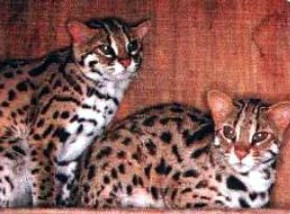
The Origin of the Bengal cat
(Bengals are Hybrid cats)
Bengals are one of the most spectacular cats because of their shining tabby coats, which provide the exotic appearance, combined with the character of a domesticated cat. Bengals are a hybrid breed created from a cross between the Asian Leopard cat (ALC) and a domesticated cat. The Asian leopard cat is a wild cat of about 4kg, 40cm long excluding a tail of 20cm. Its habitat is Southeast Asia

Jean Mill's first bengal adventure
In 1961, Jean Mill imports an ALC called Malaysia. The ALC feeling somewhat displaced on her ranch in Arizona, she decides to give it the company of a black tomcat. To her and (everyone else’s) surprise, the animals mate and a litter ensued of two kittens. The male kitten does not survive, but the female KinKin can be rescued and grows up with a litter of Himalayas. She bred KinKin back to the father (there was no other suitable available) and two more kittens were born: a nasty tempered daughter (Pantharette) and a son who sadly died after a fall. With Pantharette, she gets another kitten, but it gets eaten by the mother when it is 2 days old. Unfortunately, her husband dies in 1965, forcing her to leave the ranch and move to an apartment in California. She gives the ALC to the San Diego Zoo. KinKin and Pantharette die of pneumonia. This ends her adventure and it would not be until 1980 before she made a restart.

First hybrid litter comes to the world
In 1970, Bill had bred two litters with his ALC Shah with a total of nine kittens. He wrote extensively about this in the LIOC newsletter in 1972, see article. By the way, breeding hybrid cats from ALCs (or other exotics) was not uncontroversial at the time. The wild nature of first-generation hybrid cats caused some resistance at the time from some breeders who, on the one hand, were afraid, that these animals would end up with people who could not provide proper care, or, on the other hand, saw no reason to bring this kind of mix-breed into the world at all.
In 1970, for example, the CFA even sent out a letter (see below) in which pure ALCs were allowed to be registered and allowed to be bred with, but the letter also makes a call to refrain from crossbreeding. By the way, the crossbreeds were already known as Bengal or Leopanese back then.

The name "Bengal" registered
Bill continued his vision, however, and presented the name “Bengal” to various cat associations and agencies, officially establishing the breed’s name. The name is derived from the Latin name of its wild ancestor, Felis Bengalensis– or Asian leopard cat, as it describes itself.
The bengal breed was then the first to be accepted for registration with the ACFA (American Cat Fancier Association). Later, Bill reported that he managed to produce a number of fertile F3 males. On March 17, 1977, Bill died and his cats were taken over by friends in Florida. As far as we know, none of the current Bengals can be traced back to the Engler lines. William Engler, however, is the one known for establishing the name of the breed.

Jean Mill relaunches her breeding program
Back to Jean Mill. In 1975, she remarried Robert James Mill, who owns a one-acre horse pasture and a small orchard in the Covina hills. Despite his cat allergy, this gives her the opportunity to revive her breeding program. Her motivation is similar to Bill Engler’s. Many people are attracted to wild felines, but they are totally unsuitable to be kept by humans. By breeding a cat with the markings of a wild cat, but the character of a domesticated one, she could satisfy the demand and help protect cats in the wild. Or as she put it herself in an interview with the LA Times “A lot of people would like to have wild animals, but I don’t believe they should be allowed to have lions and tigers in their homes, and I thought that if I could breed a cat that looked wild but acted domestic, that would be a happy solution.”

First hybrid litter comes to the world
In 1980, Jean Mill is trying to secure an ALC. She contacts Capt. Zobel of California Fish and Game who refers her to Centerwall. Jean obtains four cats from him: Liquid Amber (3/4 ALC), Favie, Shy Sister and Doughnuts. Later, she gets 5 more cats from Gordon Meridith who had previously received cats from Willard for her zoo in the Mojave Desert, but had to give them away due to serious illness. These were Praline, Pennybank, Rorschach (a grayish charcoal), Raisin Sunday and Wine Vinegar (who would later eat her only kitten). She was also offered F2, but turned them down due to lack of space and her unawareness of how difficult it would be to breed further generations.

The name "Bengal" is registered
Bill continued his vision, however, and presented the name “Bengal” to various cat associations and agencies, officially establishing the breed’s name. The name is derived from the Latin name of its wild ancestor, Felis Bengalensis– or Asian leopard cat, as it describes itself.
The bengal breed was then the first to be accepted for registration with the ACFA (American Cat Fancier Association). Later, Bill reported that he managed to produce a number of fertile F3 males. On March 17, 1977, Bill died and his cats were taken over by friends in Florida. As far as we know, none of the current Bengals can be traced back to the Engler lines. William Engler, however, is the one known for establishing the name of the breed.
.
